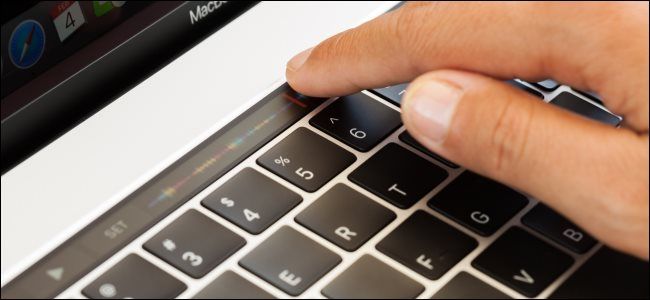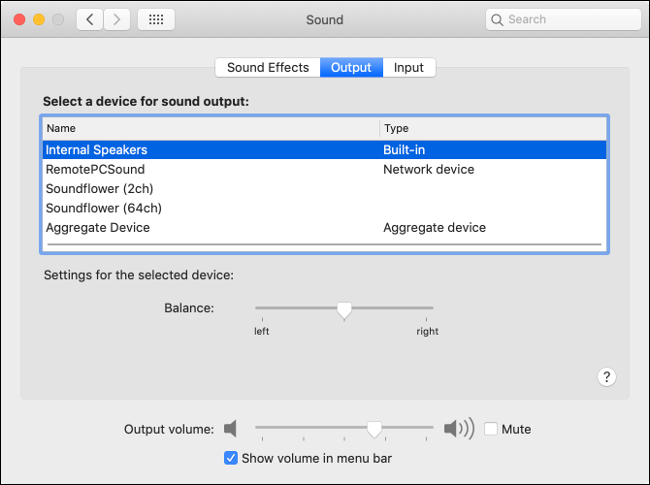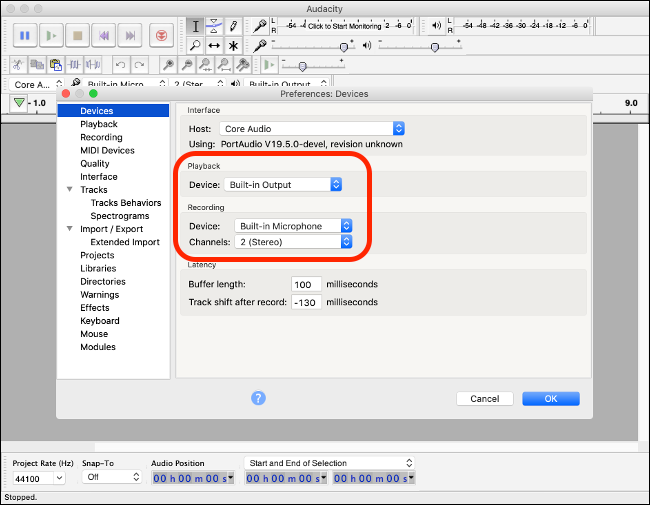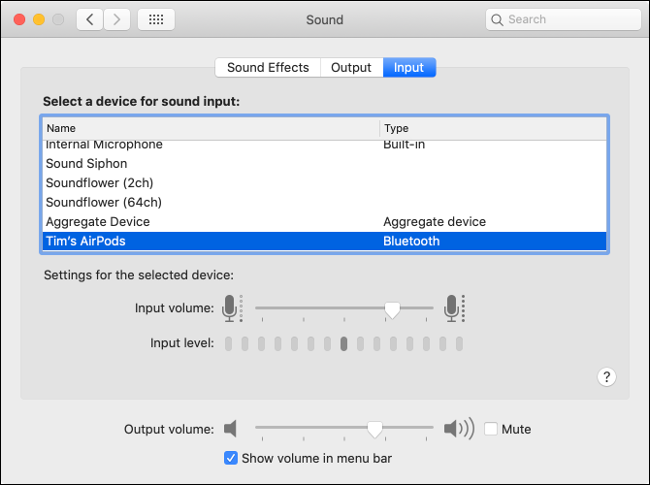Quick Links
Mac sound problems can range from stuttering crackly audio to no sound entirely. If you're running an older version of macOS, you might encounter these issues more frequently. Luckily, fixing most Mac sound problems is relatively straightforward.
No Audio on Your Mac? Check Sound Preferences
The first place to check if you are having audio problems is macOS Sound preferences. Go to System Preferences > Sound. Click on the "Output" tab and take a look at where your audio is being routed. Check the volume slider at the bottom, and uncheck the "Mute" box if necessary.
You should see a list of devices that you can use as sound outputs, with the default option (on most Mac computers) being Internal Speakers. If something other than Internal Speakers is selected (and you have no reason for that to be the case), then click on Internal Speakers to reroute the audio.
Now, test your output settings again by playing some music or an audio file. If you would rather output to another device like an audio interface, headphones, or aggregate device, you can specify that under these settings. Some sound issues can even be fixed by selecting a different output, then selecting the original output.
If you don't see any output devices at all, you might have encountered a problem when updating or upgrading macOS. You might want to try resetting your NVRAM/PRAM to solve this issue, otherwise create a backup with Time Machine and then reinstall macOS and try again.
Restarting Fixes Many Issues
If you've tried adjusting your Sound settings to no avail, restarting your Mac is probably worth a shot. This seems like a bit of a heavy-handed fix, but sometimes you really do need to turn it off and on again.
Restarting your machine will likely fix many issues, including crackling or stuttering audio. Unfortunately, it's pretty inconvenient, but it's not the only way of fixing some issues.
Fix Crackling or Garbled Sound By Killing Core Audio
Crackling or stuttering audio is a problem that plagued many around the launch of OS X 10.9 "Mavericks" in late 2013. If you have issues with your sound and you're still running Mavericks, upgrading your Mac to a newer version of its operating system is a good idea.
While you could restart your computer to fix this issue, another option is to kill the Core Audio service that is responsible for audio processing in macOS. You can do this with a simple terminal command. First, launch "Terminal," either by searching with Spotlight or under Applications > Utilities.
You'll need admin privileges for this to work. With Terminal open, enter the following:
sudo killall coreaudiod<code>
Now, enter your user password (assuming you have admin access) to authorize the command. The
coreaudiod
process will be killed and should automatically relaunch itself. Try playing some music or other sound to see if you still have the issue.
If you have no audio at all, you might need to manually restart Core Audio with the following Terminal command:
sudo launchctl stop com.apple.audio.coreaudiod && sudo launchctl start com.apple.audio.coreaudiod
You can use these commands to fix crackling audio whenever you encounter it, but a permanent fix will likely require a system update, operating system upgrade, or fresh macOS install.
Keep in mind that running this command may also interrupt any processes that rely on audio, like chatting over FaceTime or Skype, recording voice memos, or listening to music.
Resetting NVRAM/PRAM Is Worth a Shot
PRAM stands for Parameter Random Access Memory, while NVRAM stands for Non-Volatile Access Memory. This type of memory is used by your Mac to store configuration information when your computer is switched off. This includes information like the date and time, but also the sound volume settings.
Because PRAM/NVRAM is responsible for preserving sound preferences, resetting this memory may help solve some issues. If you're having consistent problems, a reset can't hurt. You might have to set the date and time and a few other macOS settings if you go this route.
How you reset your PRAM/NVRAM depends on which Mac model you have. Understand which Mac you have and how to reset PRAM/NVRAM for your particular machine.
Switch Output When Connecting HDMI Devices
Sometimes when you connect an external monitor or TV via HDMI, sound still comes out of your laptop speakers. This is easy to fix. Head to System Preferences > Sound and click on the Output tab.
You should see your HDMI device in the list of available sound outputs. Click on it, and sound will be rerouted. You could also designate another sound device (like headphones) if you wanted to output audio that way.
If you cannot see your HDMI device listed and it's definitely connected and working, try disconnecting it and plugging it back in. Your Mac should remember which device output settings you prefer in the future.
Some Sound Issues Are App-Specific
Not all sound problems are related to macOS. Some applications have their own sound preferences that must be managed manually. This includes DAW software like Ableton, video editors like Adobe Premiere, and sound-editing software like Audacity.
To rectify these problems you'll need to dig into the app's preferences. If you have no audio at all you likely need to specify an output device (like "Internal Speakers" or "Headphones"). The same can be said for a microphone that isn't working when it should be.
This differs on a per-app basis, but you can generally find most app preferences by clicking the app's name in the menu bar at the top of the screen, then clicking on "Preferences." When in doubt, a quick web search for something like "no sound mac" should yield some advice.
Microphone Problems? Back to Sound Preferences
Changing your input device is as easy as changing your output device. If you're having problems getting an app to recognize your microphone, or maybe your Mac is using the wrong microphone, head to System Preferences > Sound and click on the "Input" tab.
Whichever device is selected here is what your computer will use as a microphone. If you have connected a USB microphone, you'll need to select it here for your Mac to use it instead of the internal microphone.




